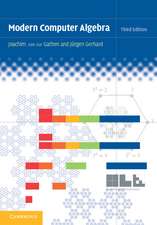MuPAD Tutorial
Autor Jürgen Gerhard, Walter Oevelen Limba Engleză Paperback – 6 iul 2000
Preț: 477.84 lei
Preț vechi: 597.30 lei
-20% Nou
Puncte Express: 717
Preț estimativ în valută:
91.44€ • 97.78$ • 76.24£
91.44€ • 97.78$ • 76.24£
Carte tipărită la comandă
Livrare economică 14-19 aprilie
Preluare comenzi: 021 569.72.76
Specificații
ISBN-13: 9783540675464
ISBN-10: 3540675469
Pagini: 361
Ilustrații: XII, 361 p.
Dimensiuni: 155 x 235 x 19 mm
Greutate: 0.53 kg
Ediția:2000
Editura: Springer Berlin, Heidelberg
Colecția Springer
Locul publicării:Berlin, Heidelberg, Germany
ISBN-10: 3540675469
Pagini: 361
Ilustrații: XII, 361 p.
Dimensiuni: 155 x 235 x 19 mm
Greutate: 0.53 kg
Ediția:2000
Editura: Springer Berlin, Heidelberg
Colecția Springer
Locul publicării:Berlin, Heidelberg, Germany
Public țintă
Professional/practitionerCuprins
1.Introduction.- 1.1 Numerical Computation.- 1.2 Computer Algebra.- 1.3 Characteristics of Computer Algebra Systems.- 1.4 Existing Systems.- 1.5 MuPAD.- 2 First Steps in MuPAD.- 2.1 Explanations and Help.- 2.2 Computing with Numbers.- 2.3 Symbolic Computation.- 3 The MuPAD Libraries.- 3.1 Information About a Particular Library.- 3.2 Exporting Libraries.- 3.3 The Standard Library.- 4 MuPAD Objects.- 4.1 Operands: the Functions op and nops.- 4.2 Numbers.- 4.3 Identifiers.- 4.4 Symbolic Expressions.- 4.5 Sequences.- 4.6 Lists.- 4.7 Sets.- 4.8 Tables.- 4.9 Arrays.- 4.10 Boolean Expressions.- 4.11 Strings.- 4.12 Functions.- 4.13 Series Expansions.- 4.14 Algebraic Structures: Fields, Rings, etc.- 4.15 Vectors and Matrices.- 4.16 Polynomials.- 4.17 Null Objects: null(), NIL, FAIL, and undefined.- 5 Evaluation and Simplification.- 5.1 Identifiers and Their Values.- 5.2 Complete, Incomplete, and Enforced Evaluation.- 5.3 Automatic Simplification.- 6 Substitution: subs, subsex, and subsop.- 7 Differentiation and Integration.- 7.1 Differentiation.- 7.2 Integration.- 8 Solving Equations: solve.- 8.1 Polynomial Equations.- 8.2 General Equations.- 8.3 Differential and Recurrence Equations.- 8.4 solve in MuPAD Versions Beyond 1.4.- 9 Manipulating Expressions.- 9.1 Transforming Expressions.- 9.2 Simplifying Expressions.- 9.3 Assumptions About Symbolic Identifiers.- 10 Chance and Probability.- 11 Graphics.- 11.1 Graphs of Functions.- 11.2 Graphical Scenes.- 11.3 Curves.- 11.4 Surfaces.- 11.5 Further Possibilities.- 11.6 Printing and Saving Graphics.- 12 The History Mechanism.- 13 Input and Output.- 13.1 Output of Expressions.- 13.2 Reading and Writing Files.- 14 Utilities.- 14.1 User-Defined Preferences.- 14.2 Information on MuPAD Algorithms.- 14.3 Restarting a MuPAD Session.- 14.4 Executing Commands of the Operating System.- 15 Type Specifiers.- 15.1 The Functions type and testtype.- 15.2 Comfortable Type Checking: the Type Library.- 16 Loops.- 17 Branching: if-then-else and case.- 18 MuPAD Procedures.- 18.1 Defining Procedures.- 18.2 The Return Value of a Procedure.- 18.3 Returning Symbolic Function Calls.- 18.4 Local and Global Variables.- 18.5 Subprocedures.- 18.6 Type Declaration.- 18.7 Procedures with a Variable Number of Arguments.- 18.8 Options: the Remember Table.- 18.9 Input Parameters.- 18.10 Evaluation Within Procedures.- 18.11 Function Environments.- 18.12 A Programming Example: Differentiation.- 18.13 Programming Exercises.- Solutions to Exercises.- Documentation and References.
Recenzii
From the reviews of the second edition:
"The software package MuPAD is a computer algebra system that allows to solve computational problems in pure mathematics … . The turotial explains the basic use of the system and gives insight into its power. … Many examples and exercises illustrate how to use the system’s functions, the graphics, and the programming language." (Zentralblatt für Didaktik der Mathematik, November, 2004)
"The software package MuPAD is a computer algebra system that allows to solve computational problems in pure mathematics … . The turotial explains the basic use of the system and gives insight into its power. … Many examples and exercises illustrate how to use the system’s functions, the graphics, and the programming language." (Zentralblatt für Didaktik der Mathematik, November, 2004)
Caracteristici
Version and platform independend introduction to MuPad Includes 88 exercises with fully worked out solutions Keeps mathematical applications on a elementary level to make this guide useful to non-mathematicians Includes supplementary material: sn.pub/extras















